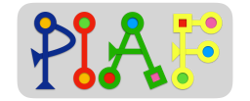Computational thinking is a fundamental skill for everyone, not just for computer scientists. To reading, writing, and arithmetic, we should add computational thinking to every child’s analytical ability.(…)
Computational thinking involves solving problems, designing systems, and understanding human behavior, by drawing on the concepts fundamental to computer science. Computational thinking includes a range of mental tools that reflect the breadth of the field of computer science.
Jeannette Wing (ACM vol. 49, n° 3, March 2006)
This definition gives a general idea about what Computational Thinking is. While strongly related to computing and computers (e.g. how to represent and process information), it also relates to other skills which are not exclusive to CT (e.g. problem solving). In order to develop these skills, we designed within PIAF a referential of competencies, where each competency is contextualized and connected to a given age span (targeting fundamental education, i.e. pupils from 5 to 12). This referential is accessible here.
In order to make it more readable, it comes with examples illustrating these competencies, and with a glossary containing definitions of terms used within the referential.
